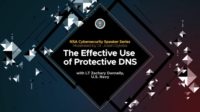Government organizations were hit by the highest number of Domain Name Systems (DNS) attacks per year, says the Global DNS Threat Report by EfficientIP.
Government suffers an average of 12 DNS attacks per year, with each attack costing an average of $558,000, amounting to $6.7 million annually. Over half (51 percent) of government organizations suffered in-house application downtime as a result of DNS attacks in the last 12 months, rendering potentially vital services inaccessible, while 43 percent faced cloud service downtime. Another 41% of organizations were impacted by compromised websites, putting data at risk. Almost one in five (19 percent) government respondents also reported sensitive information or intellectual property being stolen via DNS, by far the highest among all industries.
The typical DNS attack takes over seven hours for government organizations to mitigate, leaving the door wide open to a huge potential loss of sensitive personal and financial data, says the report. In addition, 51 percent of government respondents admitted to shutting down a server to stop an attack once underway, indicating that the countermeasures in place are not adapted to ensure service continuity.
Despite the risk, one-third (32 percent) of government respondents don’t recognize the critical nature of DNS to operations, stating DNS security is only low or moderately important, notes the report. Furthermore, one third (32 percent) of government sector respondents don’t perform analytics on DNS traffic, suggesting respondents are potentially unaware of how DNS downtime deprives users access to essential applications or government services, notes the report
David Williamson, CEO of EfficientIP, commented on the report’s findings: “With an increasing number of government services moving online, hackers have more points of attack to exploit than ever before. When 91 percent of malware uses DNS, analysis of DNS transactions is vital for uncovering these dangerous threats hidden in network traffic. In particular, the detection of data exfiltration via DNS requires visibility and analytics on transactions from the client to the destination domain. Despite this, our latest research shows governments are significantly more exposed than other sectors to DNS attacks. This is unacceptable when governments are trusted with sensitive information by their citizens, so they need to understand the potential risks to protect both themselves and the public.”
Government was tied with healthcare as the sectors putting the least importance on Machine Learning (ML) for detecting unknown malicious domains or Domain Generation Algorithms (DGAs). Government also has the lowest rate of adoption for the Zero Trust cybersecurity approach of any sector surveyed.






